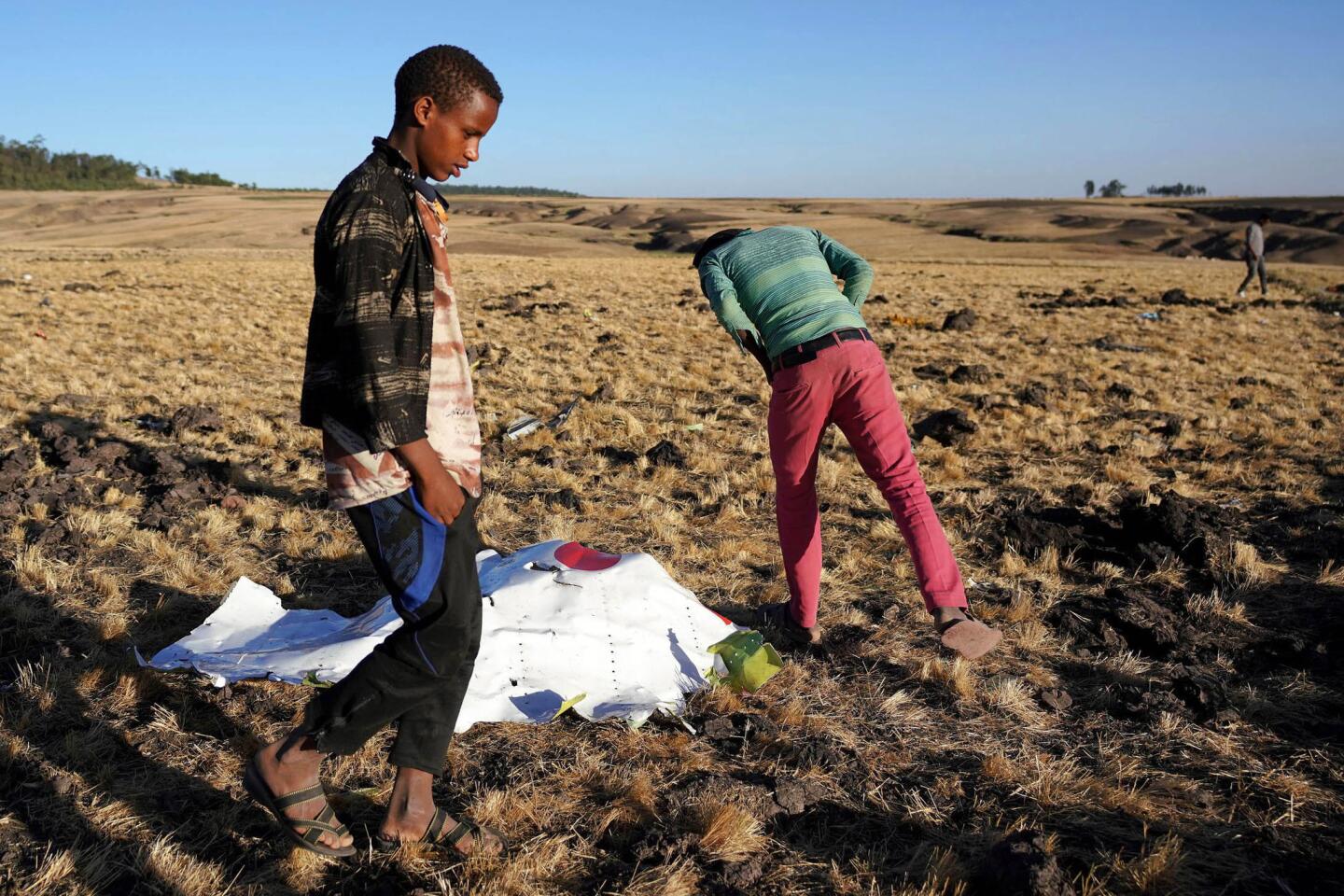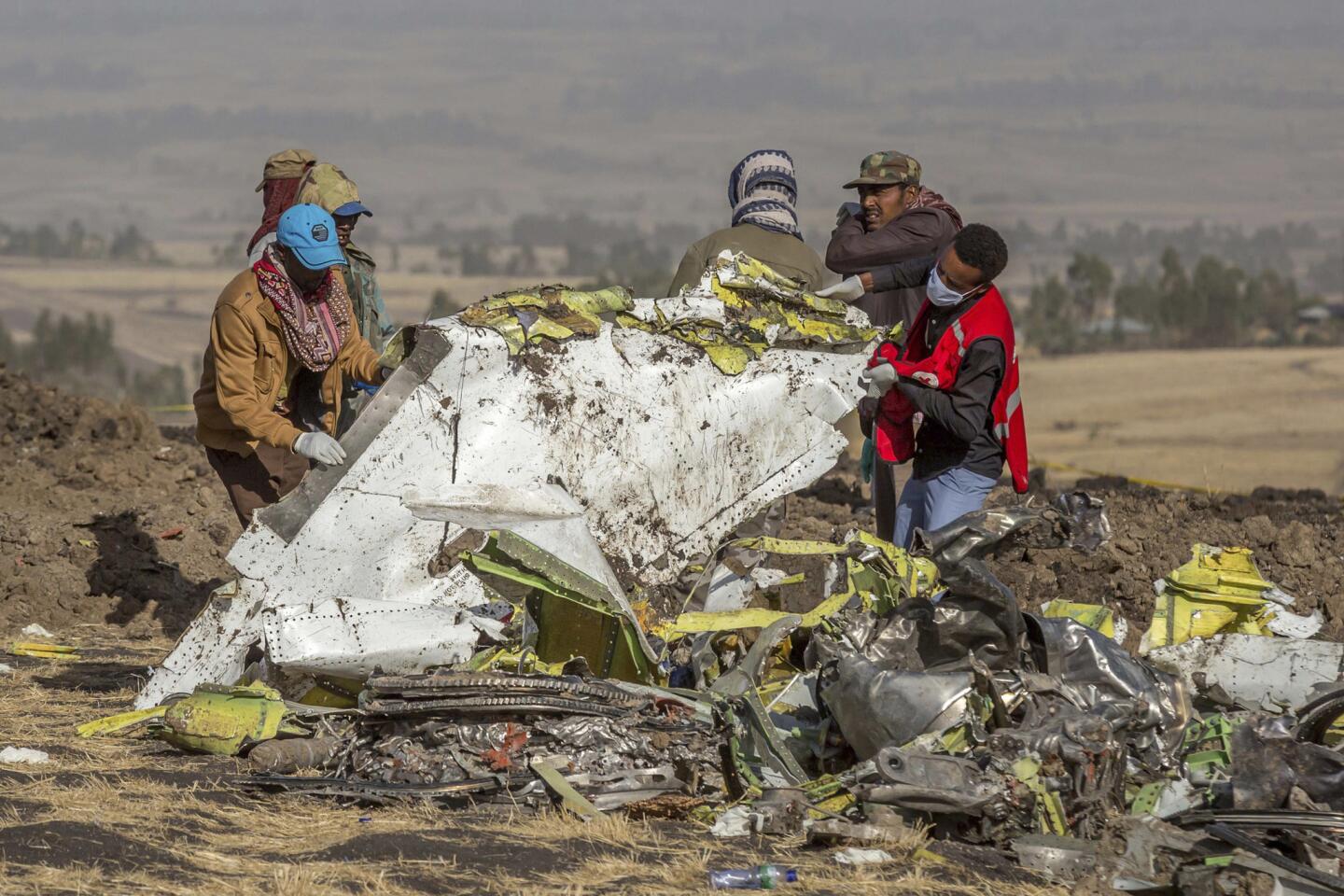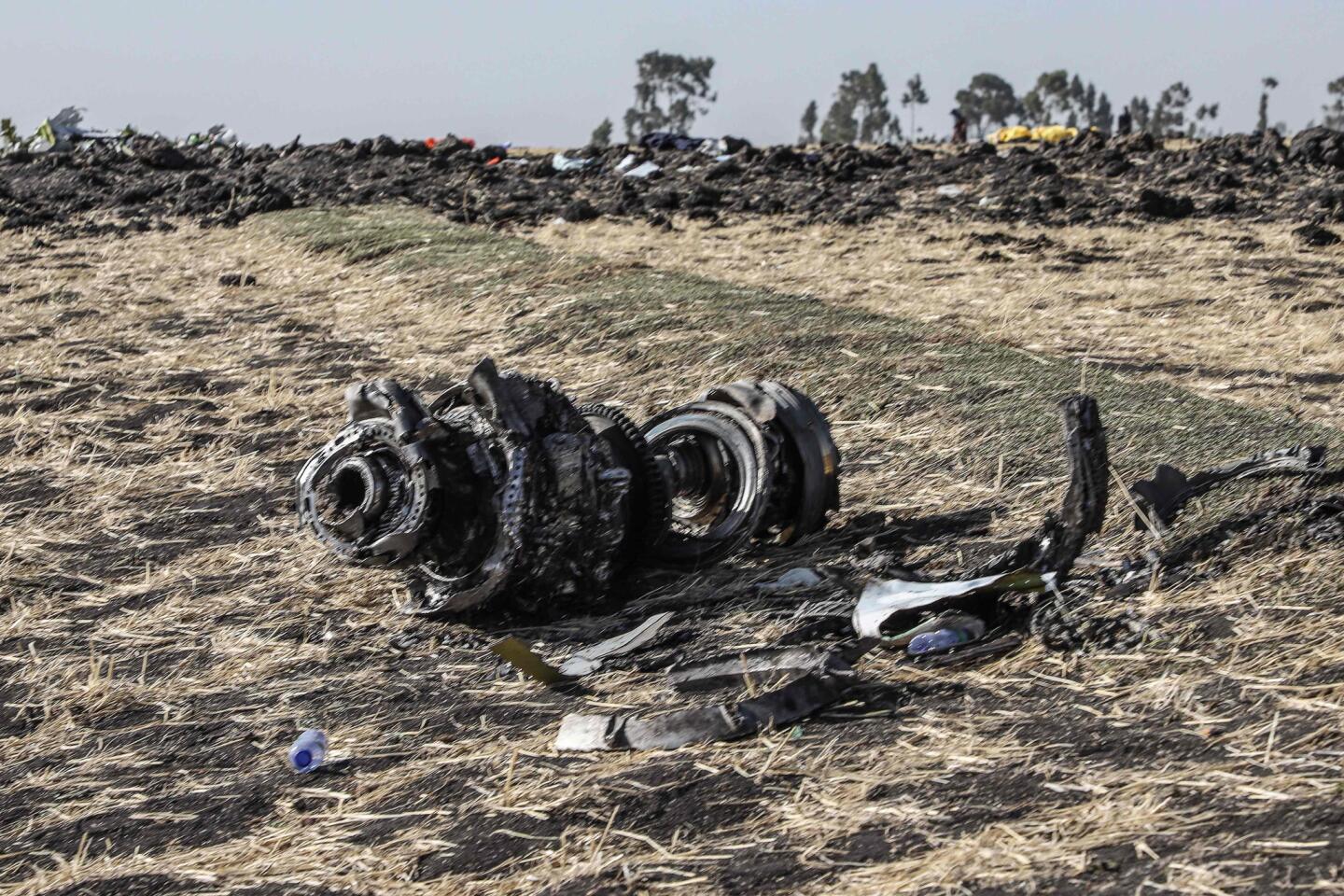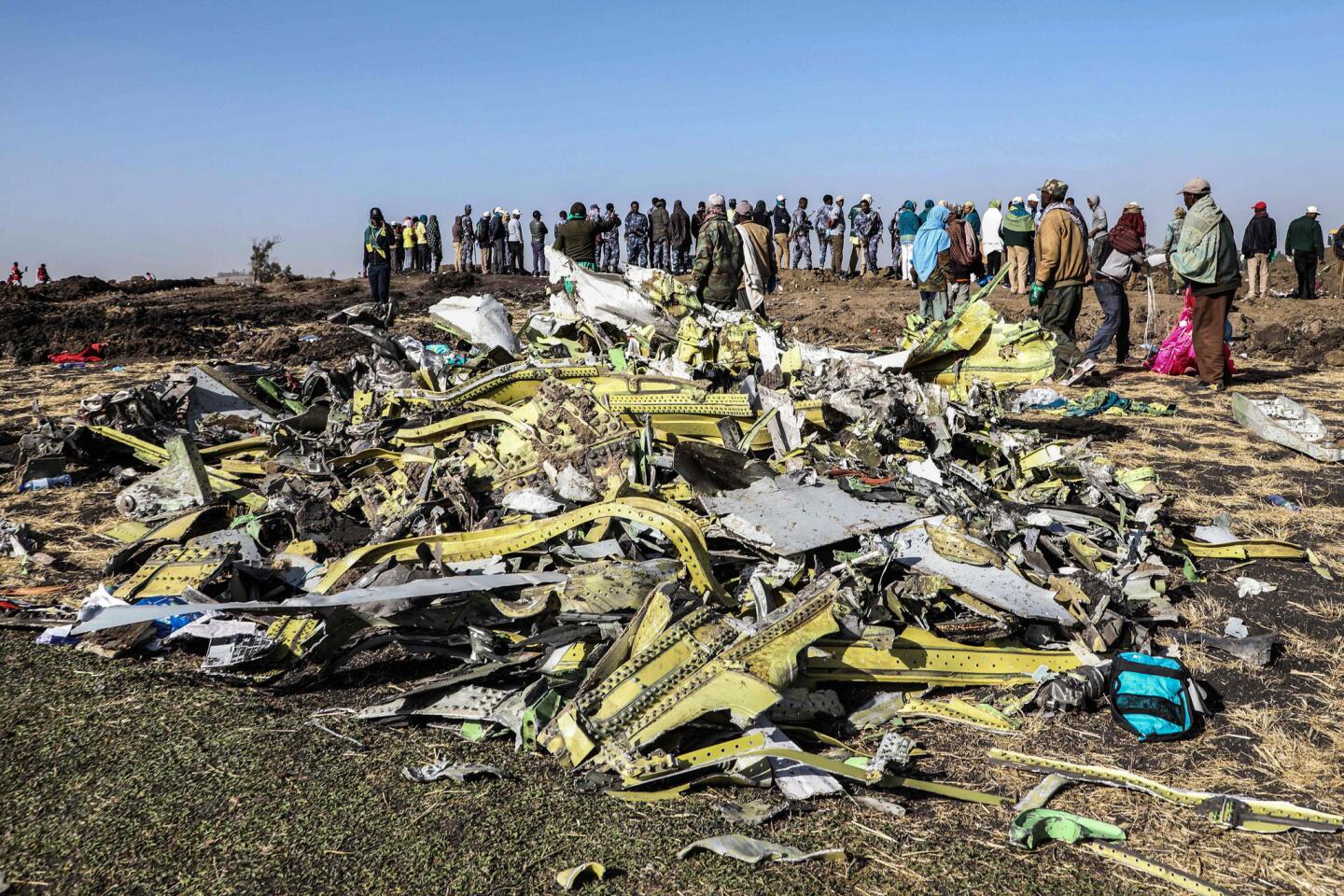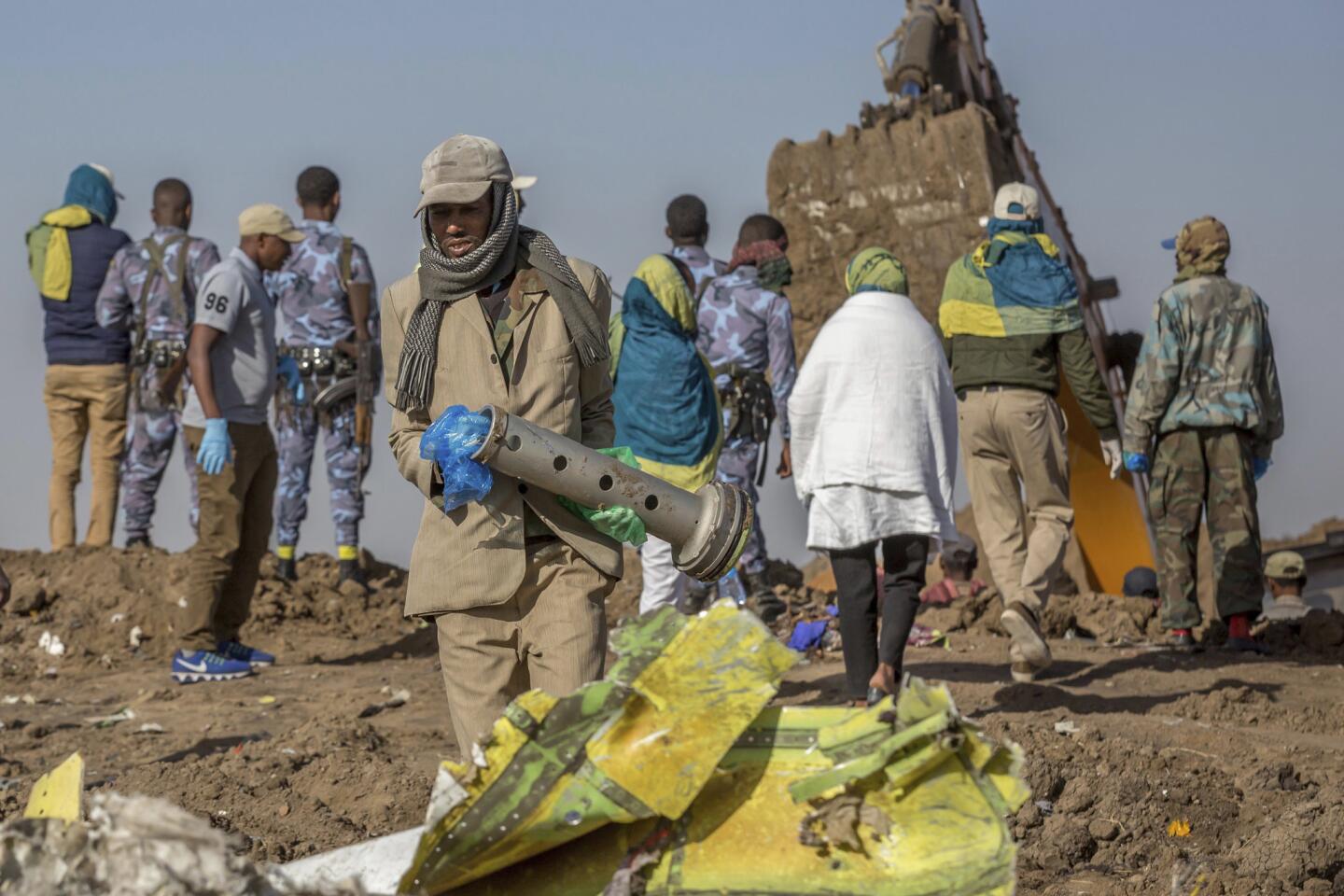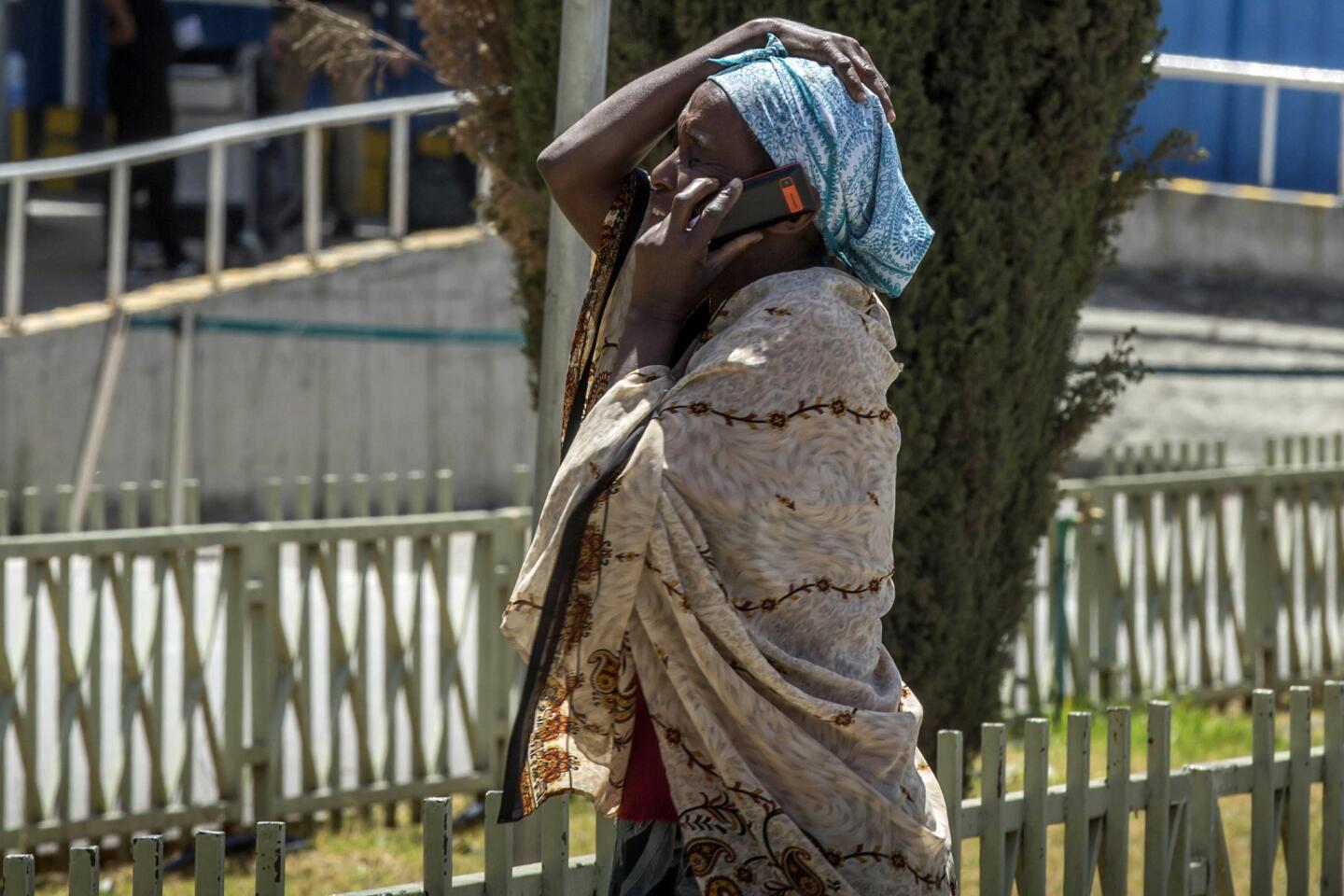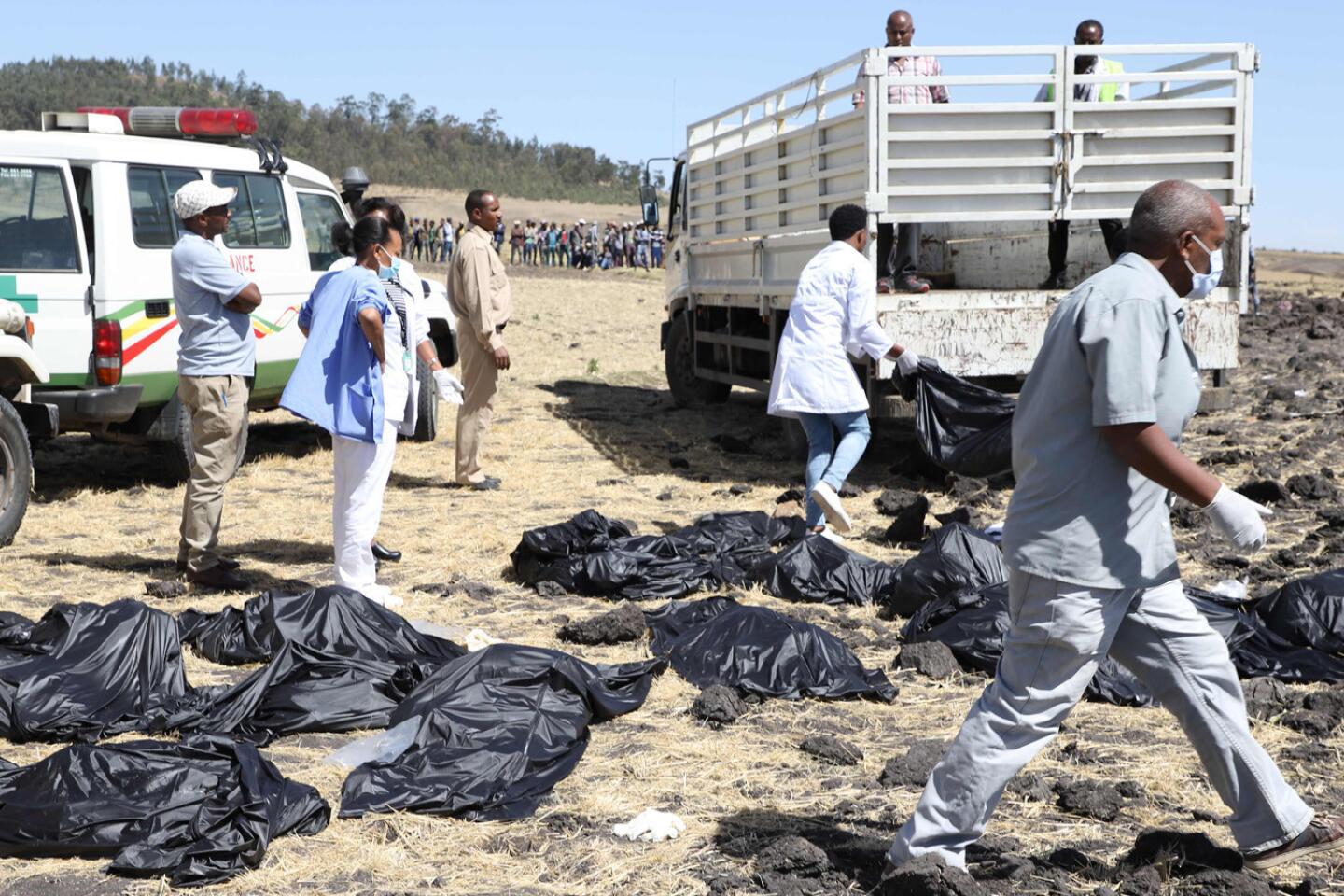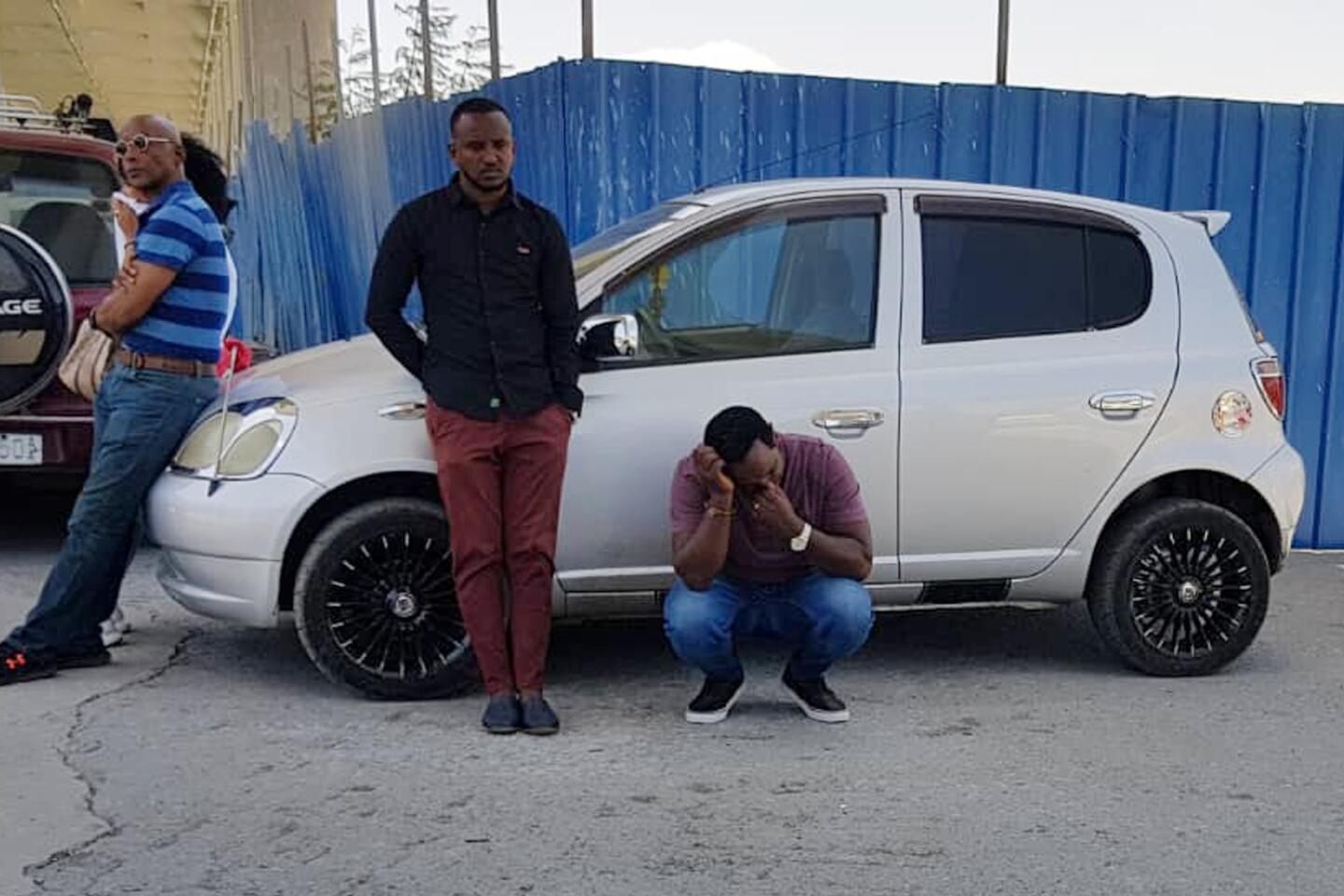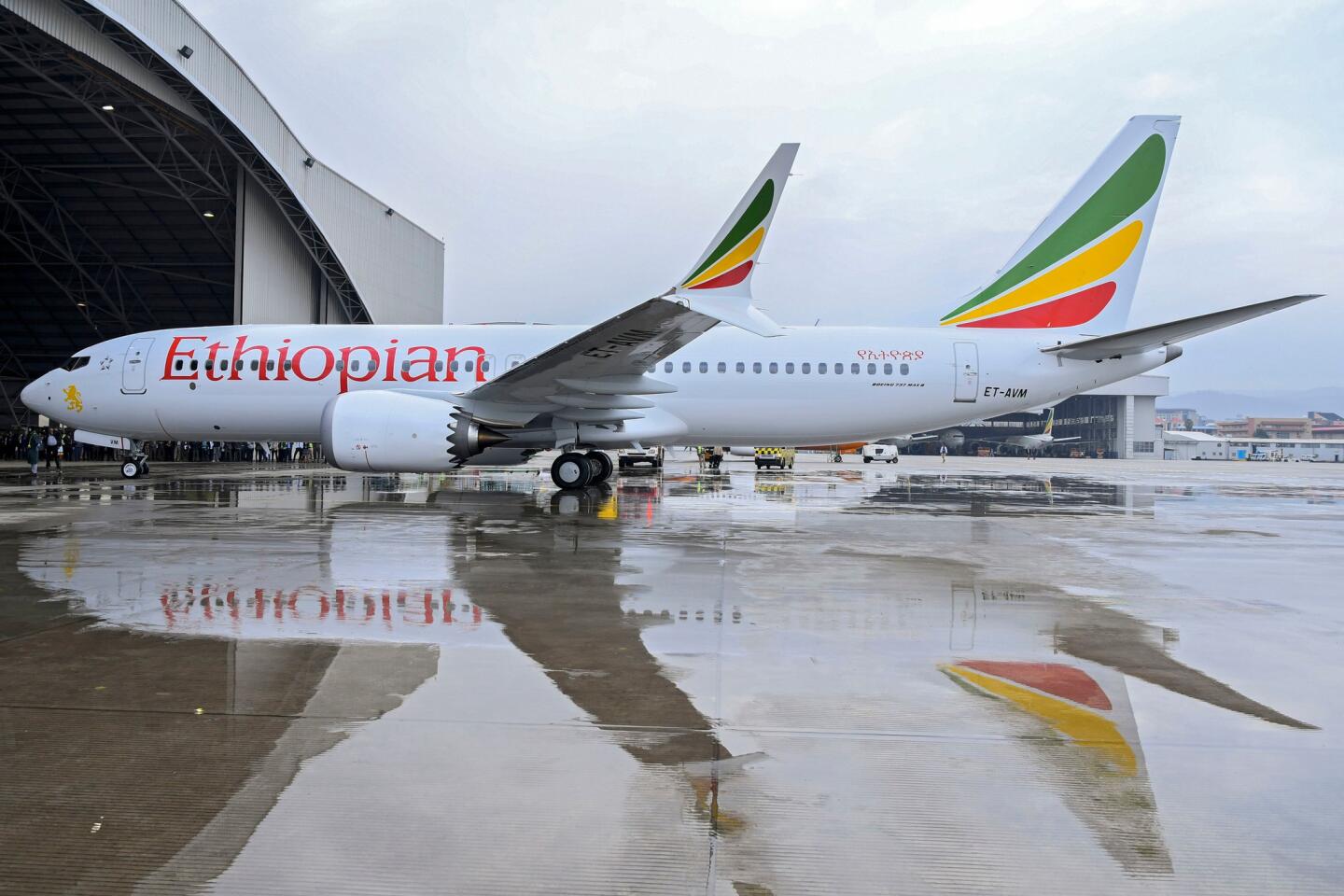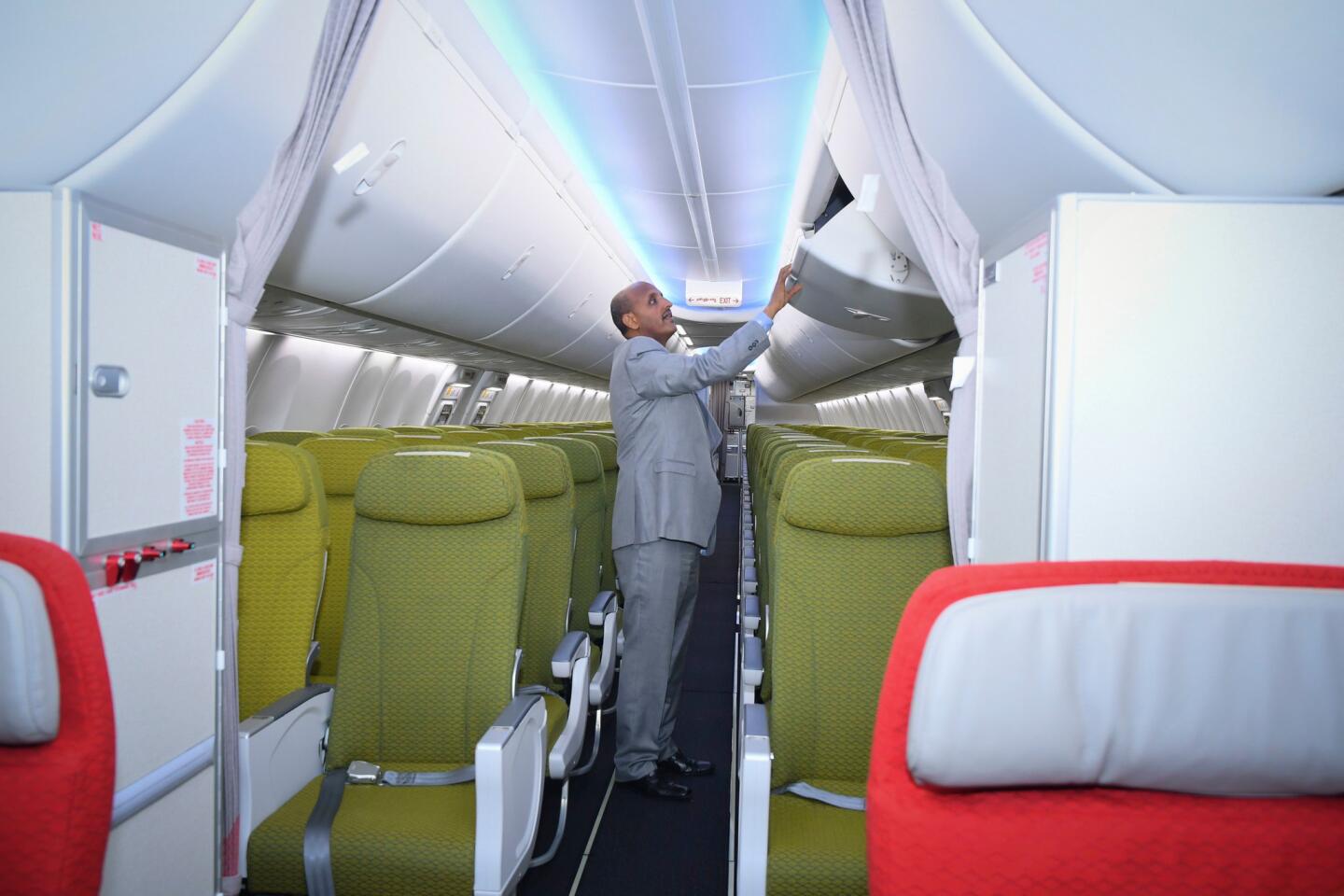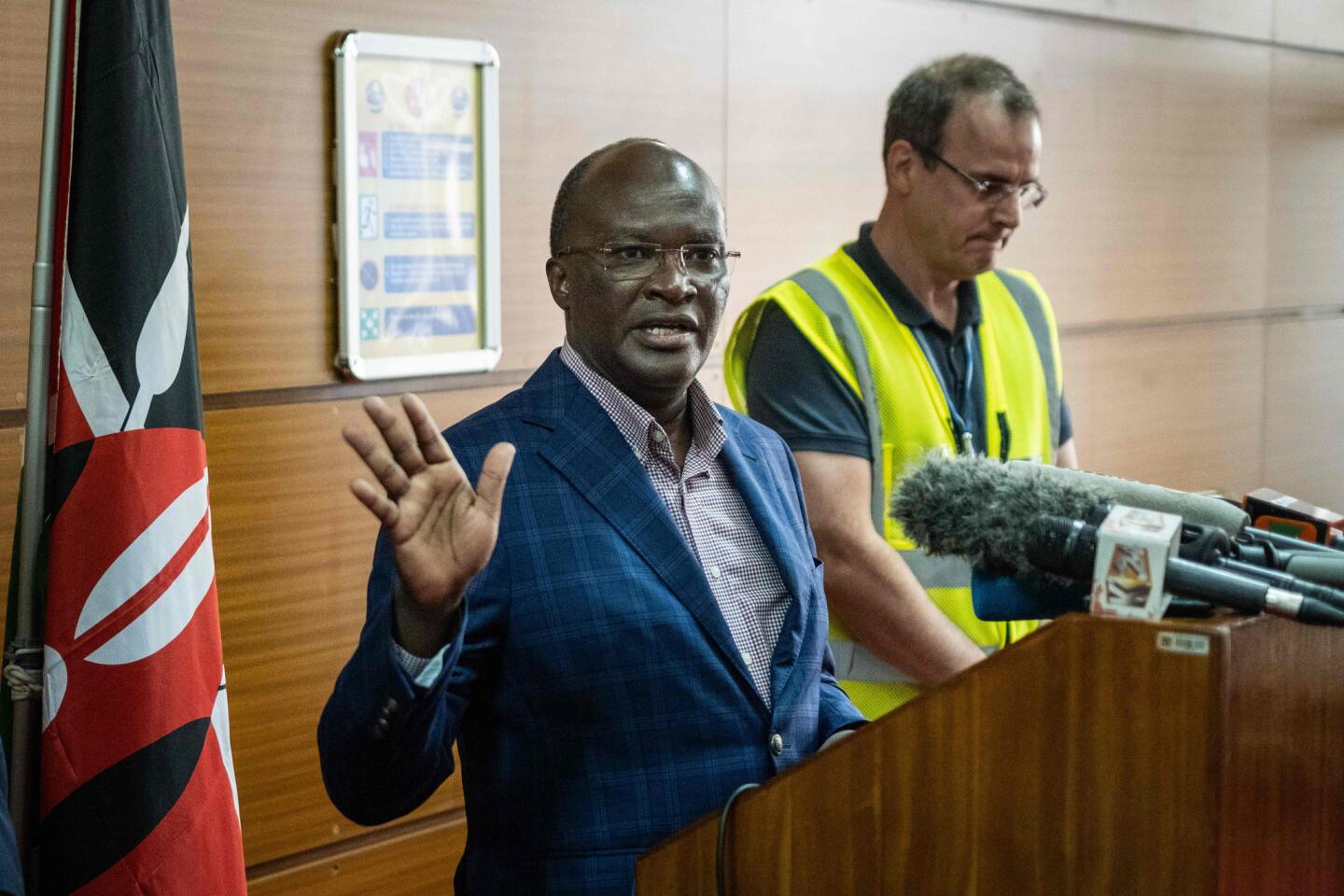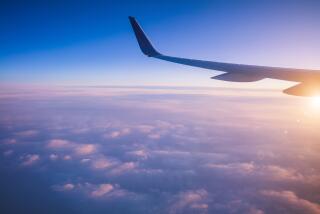Fatal crash of an Ethiopian Airlines plane raises hard questions about a mainstay Boeing jet
The crash of an Ethiopian Airlines Boeing 737 Max jetliner on Sunday, killing all 157 aboard, had uncanny similarities to a fatal accident in Indonesia five months earlier, raising disturbing questions about a mainstay aircraft that airlines have bought by the hundreds.
The flight left Ethiopia’s capital, Addis Ababa, about 8:38 a.m. on a routine flight to Nairobi, Kenya, and was expected to make a clockwise turn to the south sooner than it did. The pilot radioed the control tower and asked for clearance to return to the airport, but the plane crashed about eight minutes after it took off.
The accident is being investigated by Ethiopia’s civil aviation authorities with assistance from Boeing Co. and the U.S. National Transportation Safety Board, which are all likely to be moving as quickly as possible to determine whether the 737 Max has a serious defect that links the two crashes. Safety officials emphasized that it is too early to reach any conclusions about the cause of Sunday’s crash.
But the potential effect on Boeing was driven home late Sunday when Chinese officials ordered local carriers to ground the 96 737 Max planes they operate, according to Bloomberg. China is one of Boeing’s most important markets.
Boeing has received total orders for 5,000 of the twin-engine jetliners from airlines all around the world and already more than 300 are in service, increasing the urgency of finding out what happened.
Only in October, another 737 Max, operated by Lion Air in Indonesia, crashed after takeoff from Jakarta after experiencing mechanical and software problems that led it into a series of dives. The accident killed 189 people.
“With two accidents on this brand-new airplane, everybody is hyper-focused,” said Steven Wallace, former director of accident investigations at the U.S. Federal Aviation Administration. “Investigators don’t want to jump to conclusions, but the Lion Air accident is on their mind.”
Aviation experts say the two crashes differ in many respects, but notably both jetliners appear to have had unexpected altitude drops shortly after takeoff. In the Lion Air accident, the pilots battled about a dozen nose-down movements that were caused by automated systems. It is unknown what caused the Ethiopian altitude drops.
After Ethiopian Airlines Flight 302 took off from Bole International Airport, it immediately began to experience difficulty, Tewolde GebreMariam, chief executive of the airline, told local news media. The executive said the plane had just flown to Johannesburg and back with no mechanical problems reported.
The plane took its first flight in October and had barely entered service in Africa by Sunday. It was on a scheduled two-hour flight to Nairobi.
The aircraft climbed slowly after its wheels left the ground, then descended about 400 feet, climbed again and then plunged into a rural area. It carved a large crater near the city of Bishoftu, southeast of the capital, according to data supplied by Flightradar24, a Swedish company that tracks flights around the world. The accident killed eight Americans, 18 Canadians, 32 Kenyans and nine Ethiopians.
John Cox, a veteran pilot and air safety expert, said it is unusual for a big jet to lose altitude as it climbs after takeoff. But he said it could happen if the pilots are hand-flying the aircraft and become momentarily distracted. “We don’t know why the pilots said they wanted to return to the airport,” he said.
Experts said that if investigators find a link between the two crashes, the FAA may be forced to take tough action.
“If the FAA determines it is the same problem, it is very possible that it could ground the plane,” said Douglas Moss, an instructor at USC’s Viterbi Aviation Safety and Security Program, a former United Airlines captain, an attorney and a former Air Force test pilot. “I am sure the FAA would consider it.”
Such a tough measure is seldom taken, though. The McDonnell Douglas DC-10 sustained four fatal crashes for different defects in its early years in the 1970s, including a weak engine mount and a defective cargo door, leading the FAA to ground the plane in June 1979. In the last 40 years, aircraft have become far safer because of improved cockpit electronics, better air frame designs and more reliable engines.
The fuel-efficient 737 Max is far more important to worldwide aviation than the DC-10 was at the time. Southwest Airlines, which has dozens of flights at airports in Southern California, is the biggest customer, with orders for 280 of the jets, and plans to use it on a route to Hawaii.
The Lion Air crash has some similarities and differences. Lion Air’s 737 Max had a series of sensor problems that had been reported in the days before the crash and which mechanics had failed to remedy. A preliminary accident report shows that the pilots desperately tried to control the aircraft’s attitude as it entered a series of about a dozen dives that ultimately took it into the Java Sea.
That plane began having problems with the failure of a sensor that measures the plane’s angle of attack, which measures the angle that air is flowing over the wings. The cockpit software took the erroneous data and determined incorrectly that the plane was about to stall and sent it into a series of dives to correct the problem.
The Boeing software is called “maneuvering characteristics augmentation system,” or MCAS. The pilots could have solved the control problem just by flipping two switches to disable the MCAS software.
The 737 Max has bigger, more fuel-efficient engines than earlier 737 models. That shifts the plane’s center of gravity, creating a potential for its nose to pitch up after takeoff. Such a nose-high attitude can reduce the lift from the wings to the point that the aircraft literally starts to drop out of the sky.
To safeguard against such a condition, the MCAS software automatically adjusts the plane’s rear stabilizer to counteract pitch up.
When it introduced the 737 Max, Boeing did not recommend or require specific pilot training on MCAS. The company has come under sharp criticism for not doing more to inform pilots and encourage more training in the software system.
In a message to employees after the Lion Air crash, Boeing Chief Executive Dennis Muilenburg said “the 737 MAX is a safe airplane.” He denied media reports that “we intentionally withheld information about airplane functionality from our customers” and said “the relevant function is described in the Flight Crew Operations Manual.”
After that accident, however, the FAA issued an airworthiness directive that called the matter an “unsafe condition,” reviewed the correct procedures for disabling MCAS and said it was continuing to review the matter.
Such directives must be followed by U.S. airlines, but foreign carriers are not under the same legal requirements. “There is a chance they would not have enforced the directive and not informed the pilots,” Moss said. “Every American pilot would know just by reading the news. You would think anybody who reads the news would know. But you just don’t know.”
The Flightradar24 data shows that the Ethiopian Airlines aircraft had a top speed near the end of its flight of nearly 400 knots at 8,600 feet, far above the allowable speed for that altitude. And it shows that the vertical air speed of the jet changed as many as 10 times during the first three minutes.
Bole International Airport is at an elevation of 7,200 feet, fairly high for a commercial airport. So the plane had gained that much speed after climbing only 1,400 feet.
“Normally, you don’t go above 250 knots below 10,000 feet,” Wallace said. One possibility is that the pilots had set engine power for a climb and then the plane entered a dive, which caused a rapid gain of speed, Wallace said.
The Flightradar24 data covers only the first three minutes of the flight, so there is a big data gap over the following five or so minutes. That makes getting the flight data recorder and the voice recorder all the more essential. Cox said that they may well be taken to the NTSB in Washington, where the data could be extracted as quickly as possible.
GebreMariam, the airline’s CEO, said the senior pilot had 8,000 hours of experience. Ethiopian Airlines is considered among the best of the developing world’s airlines, operating a new fleet of 777, 737 Max and 780s. By contrast, Lion Air had gained a poor reputation for training and maintenance even before the accident in October.
“Ethiopian Airlines deserves a very good reputation,” Cox said.
Follow me on Twitter @rvartabedian
More to Read
Sign up for Essential California
The most important California stories and recommendations in your inbox every morning.
You may occasionally receive promotional content from the Los Angeles Times.
